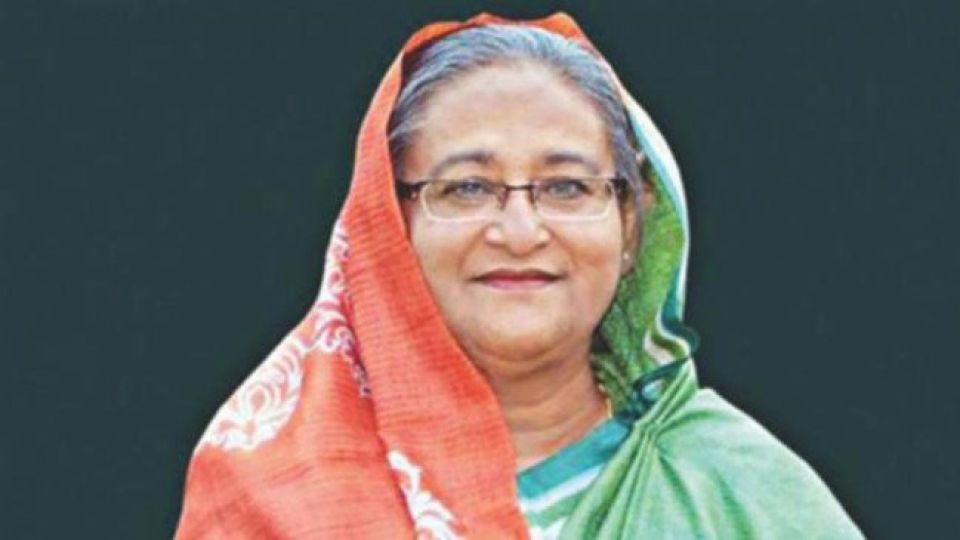February 13, 2025
DHAKA – Ousted prime minister Sheikh Hasina herself had ordered the killing of students and protesters during the July uprising, the United Nations Fact Finding Mission said, citing senior security officials.
” …The prime minister herself told security force officials to kill protesters to quell the protests and specifically demanded ‘arrest the ringleaders of the protests, the troublemakers, kill them and hide their bodies’,” said the report released yesterday, quoting testimonies of officials about a meeting on July 19, 2024.
“This testimony is also consistent with Awami League secretary general and government minister Obaidul Quader telling reporters on July 19 that security forces had been given orders to ‘shoot on sight’, an instruction manifestly incompatible with international human rights standards,” added the 114-page report.
The evening before, then home minister Asaduzzaman Khan Kamal chaired a meeting where he ordered the Border Guard Bangladesh (BGB) to shoot using lethal weapons, found the mission which had interviewed a participant in the meeting.
“On the evening of July 18, the then home minister chaired a meeting of the ‘Core Committee’, attended by the heads of Police, Rab, and Border Guard Bangladesh and intelligence leaders. At the meeting, the minister told the BGB commander, in front of the other senior security sector leaders, to order use of lethal force much more readily,” the report read.
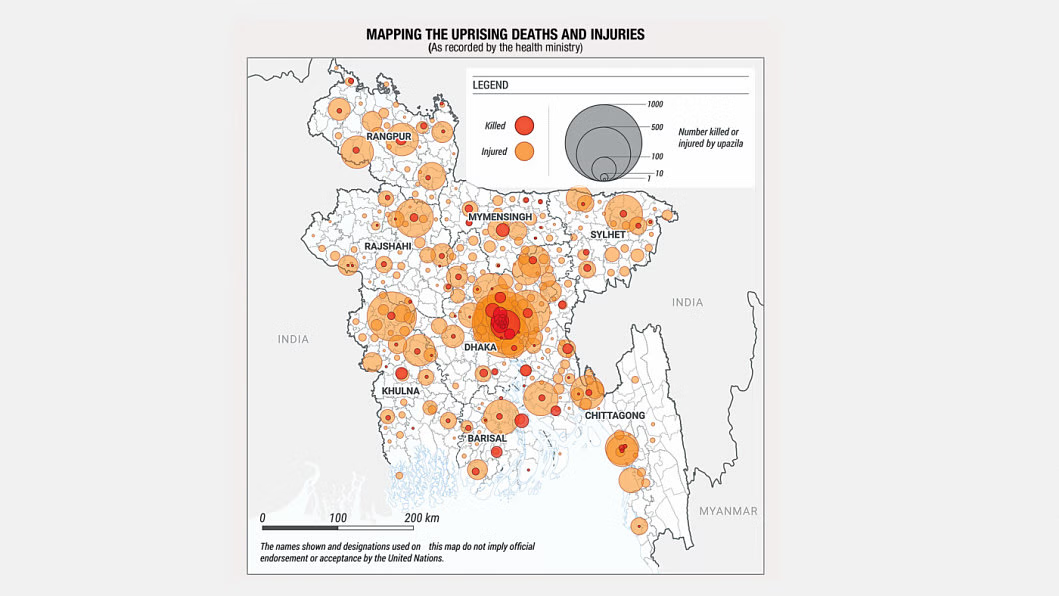
GRAPHICS: THE DAILY STAR
While launching the report at a press conference in Geneva yesterday, United Nations High Commissioner for Human Rights Volker Turk said, “Crimes against humanity have been committed.”
“… Additional criminal investigations are warranted to determine the extent to which they [serious human rights violations] may also amount to crimes against humanity and, torture (as a stand-alone international crime), as well as serious crimes under domestic law,” the report said.
“Office of the United Nations High Commissioner for Human Rights [OHCHR] has reasonable grounds to believe that these violations were carried out with the knowledge, coordination, and direction of the political leadership and senior security sector officials, in pursuance of a strategy to suppress the protests and related expressions of dissent.”
The serious human rights violations and abuses committed by the security forces and armed Awami League supporters between July 15 and August 5 stemmed from a calculated effort to retain power at all costs, it said.
The mission interviewed 230 witnesses for the purposes of preparing the report. It assessed that as many as 1,400 people could have been killed during the uprising.
The report said Hasina and Asaduzzaman Khan led parallel efforts to coordinate the security and intelligence apparatus.
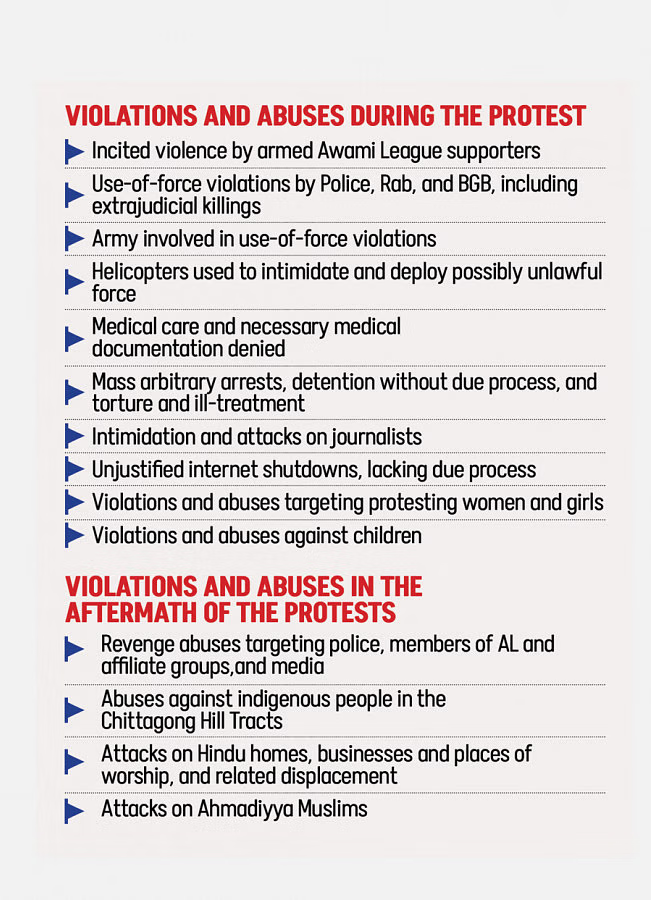
GRAPHICS: THE DAILY STAR
“Both received regular reports on the situation on the ground from multiple sources. According to senior official testimony, reports provided to the prime minister by senior officials on July 21 and in early August specifically conveyed concern about excessive use of force.”
The mission in its report elaborated the roles each security force and law enforcement agency as well as the Awami League played.
“From July 19, until the end of the protests, BGB, Rab and police fired lethal ammunition indiscriminately at protesters in Dhaka and elsewhere,” it said, adding, “On July 20, the former government imposed a general curfew and deployed the army. The OHCHR documented three instances in which the army deliberately shot military rifles loaded with lethal ammunition at protesters. On July 20, in Mohammadpur and in front of the BTV, and on August 5, in front of the Jamuna Future Park.
The report named agencies that had directly engaged in perpetrating human rights violations — the Directorate General of Forces Intelligence (DGFI), National Security Intelligence (NSI), the National Telecommunication Monitoring Centre (NTMC), Detective Branch of police, Special Branch of police, and the Counter Terrorism and Transnational Crime unit (CTTC).
“They shared intelligence, including information obtained through surveillance in violation of the right to privacy, to enable the campaign of mass arbitrary arrests that took place in late July,” said the report.
The DB routinely resorted to arbitrary detention and torture to extract information and confessions from detainees. The CTTC headquarters also served as another location where many of those detained arbitrarily, including children, were held, said the report.
“DB and DGFI colluded in the abduction and arbitrary detention of student leaders and sought to coerce them to renounce the protests,” it said, adding that DGFI, NSI and DB obstructed lifesaving medical care, frequently interrogated patients in hospitals, arrested injured persons, and intimidated medical personnel and staff.
The NTMC worked together with the Bangladesh Telecommunications Regulatory Commission to implement ministerial orders imposing strategically timed and targeted internet shutdowns.
“In parallel, DGFI, NSI and Rab pressured media outlets not to report fully and truthfully about the mass protests and their violent suppression. DGFI joined the police in intimidating victims, their families, and lawyers to ensure their silence,” it said.
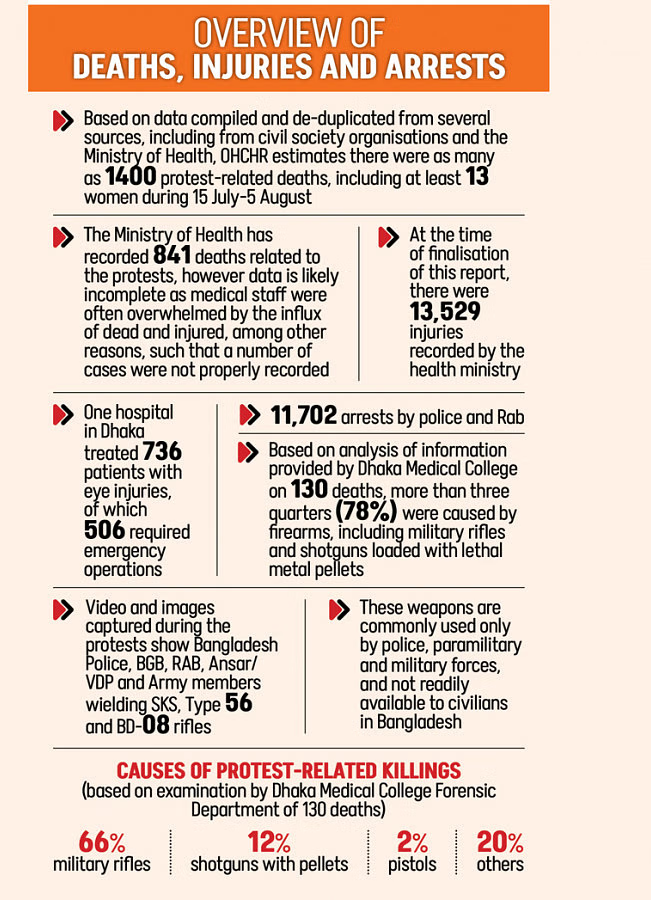
GRAPHICS: THE DAILY STAR
The mission also conducted ballistics and forensic tests to determine what kinds of weapons were used and by whom. It also scrutinised dozens of incidents of firings at protesters.
As many as 66 percent of all the deaths were caused by military-grade rifles, while a further 12 percent were caused by shotguns loaded with metal pellets, found the fact finding mission.
Security forces deliberately killed or maimed defenceless protesters by shooting them at point-blank range. They fired indiscriminately and extensively at the entire crowd with lethal ammunition, failing to distinguish between peaceful protesters, property vandals, and the few individuals on the scene who actually posed a threat of death or serious injury, said the report.
“Bystanders were often among the victims, including young children,” the report said.
The report of police and Rab to OHCHR confirmed that rifles with 7.62x39mm ammunition were used by police in Dhaka, Chattogram, Sylhet, Gazipur, Narayanganj, Narsingdi, Kishoreganj, Cox’s Bazar, Cumilla, Chandpur, Rajshahi, Chapainawabganj, Bogura, Magura, Bhola, Mymensingh, and by Industrial Police, Armed Police Battalion, and Rab.
“The police, including Dhaka Metropolitan Police, Sylhet Metropolitan Police, Manikganj District Police, and Armed Police Battalion, also used what the police described as 7.62x39mm calibre submachine guns (SMGs).
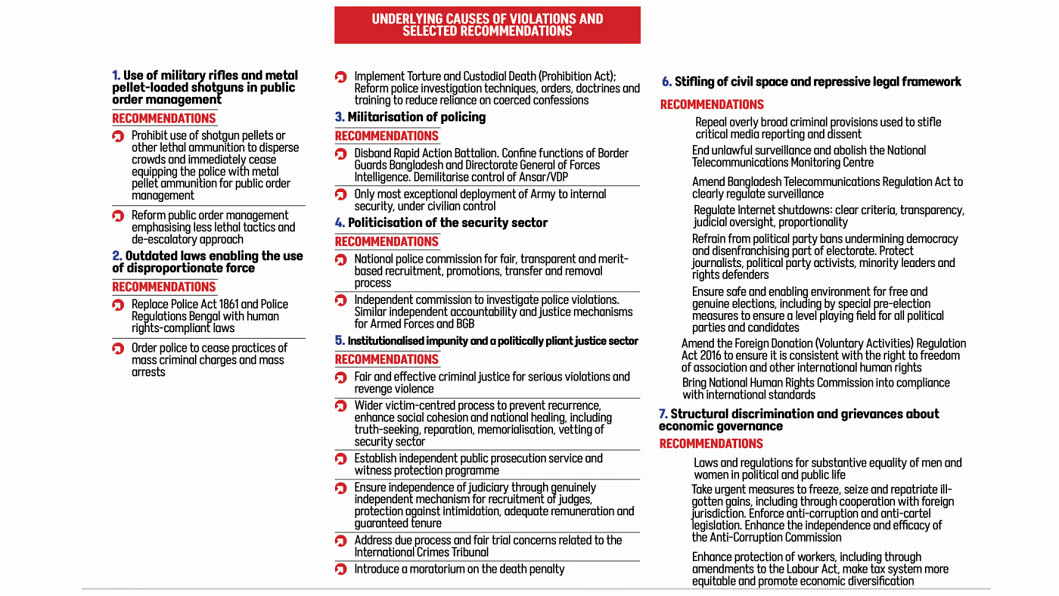
GRAPHICS: THE DAILY STAR
“In Bangladesh, shotguns are standard issue weapons in public order management. Police officers bearing them are deployed with ammunition cartridges containing up to two hundred 2-3mm metal pellets and with other cartridges filled with less lethal ammunition consisting of six to eight larger rubber bullets.”
It said that in 2022 and 2023, the police, with the authorisation of the home ministry, ordered more than three million metal shot cartridges. This was over double the number of rubber bullets ordered during the same period.
The report said it was a strong indication of the high level of reliance on, and widespread use of, lethal metal shots by the police. Police officers in the field had broad discretion to decide when to deploy metal shots and when to use rubber bullets.
Abu Sayed, a student in Rangpur, was killed by lethal metal pellets resulting from at least two shots from a distance of approximately 14 metres, the mission found.
It said at least 40 metal pellets were found on the right side of his chest and 50 on the left, including in areas around the heart and lungs, and in the abdomen, causing internal bleeding.
The mission called him a victim of a deliberate extrajudicial killing by the police.
“On the morning of July 18, police — reinforced by Rab, Armed Police Battalion, BGB, Ansar and armed Awami League supporters — positioned themselves at BNS Centre in Uttara, in anticipation of a major protest that was scheduled that morning.
“Witnesses described police and Rab firing lethal ammunition from military rifles from different locations at protesters. Witnesses and images also confirm the police shooting from the rooftop of Uttara Police Station.
“Hundreds of protesters suffered gunshot wounds, and several were shot dead. One nearby hospital recorded 91 injured patients and six deaths on that day, out of which five were students. Medical and ballistics information analysed by OHCHR confirmed that victims were shot with lethal ammunition commonly used by the police and Rab,” it said.
One of those who died there was Mir Mugdho, who suffered a fatal shot to the head.
The report details an incident in Savar. “Protesters, some carrying sticks, sought to block an important intersection on the Dhaka-Aricha highway. Police supported by the BGB were deployed in advance, presumably to prevent the road from being blocked. Awami League supporters armed with machetes, sticks, and shotguns lined up in front of the police.
“One of the local party leaders was armed with a pistol-calibre submachine gun that would ordinarily only be available to state forces.”
At the press conference in Geneva, Rory Mungoven, chief of the Asia-Pacific Region of OCHCR, said, “Militarisation of policing is a massive problem in Bangladesh…. Politicisation of policing is one of the significant findings.”


